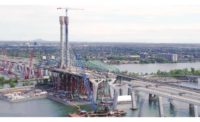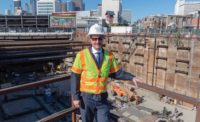Amid intense media attention, a design-build team on July 16 closed one of the most congested highway stretches in the country, demolished half an iconic bridge and reopened the 10-mile stretch to traffic 17 hours ahead of schedule—and earned a $300,000 bonus.

The $1-billion Sepulveda Pass widening will add high-occupancy vehicle lanes to a stretch of Interstate 405 in Los Angeles. The last of three bridges to be demolished and rebuilt, the Mulholland Bridge is the most significant. “We built it in 1959,” says Dan Kulka, spokesman for Kiewit Infrastructure West, the design-build team's lead contractor. “And now we will rebuild it.”
The concrete box structure—72 ft wide, 579 ft long and 80 ft high, with a 253-ft center span—was the longest of its kind in the western U.S. when built. Its replacement will be 10 ft wider and 30 ft longer and upgraded to the latest seismic standards, according to the Los Angeles County Metropolitan Transportation Authority (L.A. Metro), which is partnering with the owner, the California Dept. of Transportation, on the design-build job.
The anticipated 53-hour shutdown of the 10-lane stretch, which connects to Interstates 10 and 101, engendered public buzz about “carmageddon,” with celebrities and politicians joining a campaign to encouraging Angelenos to avoid driving that weekend. “We were before the world, streaming live, and we needed to perform,” says Kulka. “And we had an enormous amount of work to do.”
The section closed Saturday night as some 100 workers prepared to tear down the southern half of the three-span bridge with diamond saws, jackhammers and hoe rams. “If you gain a few minutes on every single different operation, then you end up way ahead of schedule,” Kulka says.
Crews used a large, diamond-bladed saw to cut the top deck, soffit and slots in the south side of the bridge. The jackhammers “nibbled” away at some 4,000 tons of concrete, which will be recycled for building the new southern half. Working toward opposite ends of the bridge, two hoe rams began demolition in the center, each using up to 1,200 ft-lb of power to break away concrete, according to L.A. Metro officials.
The operator-handled machines delivered up to 600 blows per minute to break pieces into basketball-sized chunks. Front-end loaders shifted the debris into trucks. With acetylene torches, crews cut steel rebar from the deck. Workers performed vibration monitoring and other tests to ensure the structural integrity of the northern half of the bridge.
Because of the potential damage to the roadway from falling bridge debris, Kiewit allowed significant time for repairs and created a 4-ft-thick dirt bed to cushion the freeway. But when the bridge was cleaned and swept, a team of inspectors went through and found no damage, says Kulka. “It was in great shape, so we just striped it and opened it up,” he says.
Crews are beginning to build the new southern half of the bridge and plan for the demolition of the northern half, expected to happen in a year, says Kulka. He says the northern half will be more complicated because it will entail demolishing four girders and four columns, rather than three girders and two columns.
Squeezed on All Sides
The demolition of the Mulholland Bridge is a milestone in what is currently the largest design-build highway project in California. Kiewit Infrastructure West Co. leads a team including HNTB Corp. as lead designer and Kleinfelder Inc. as lead geotechnical engineer. The team won the contract in 2009.
The goal is to widen existing lanes and add a high-occupancy lane to the north side of I-405 through the Sepulveda Pass in the Santa Monica mountains, a stretch that carries 300,000 vehicles daily.
What might have been a relatively straightforward expansion is complicated by the fact that the stretch travels not only through a tight cut in the rugged mountains, but goes past affluent communities in Los Angeles. Construction activities must co-exist with influential entities like the J. Paul Getty Center, the Skirball Cultural Center, and the American Jewish University, says Mike Barbour, L.A. Metro project director.
For example, a planned interchange depends on successful negotiation with a veterans' administration center for access to one of its nearly 400 acres, or “the interchange would have sharper curves and reduced sight lines,” Barbour says.
The project requires improvements to a total of 23 structures, 18 miles of retaining and sound walls and avoidance of clashing with a 96-in.-diameter water pipeline that crosses beneath the freeway. The team also discovered unexpected patches of unsteady soil, with danger of landslides, in nearby slopes within private property rather than Caltrans rights of way. Two massive soil nail walls as high as 86 ft have been constructed to help protect the highway from sliding earth during excavation and construction.






Post a comment to this article
Report Abusive Comment